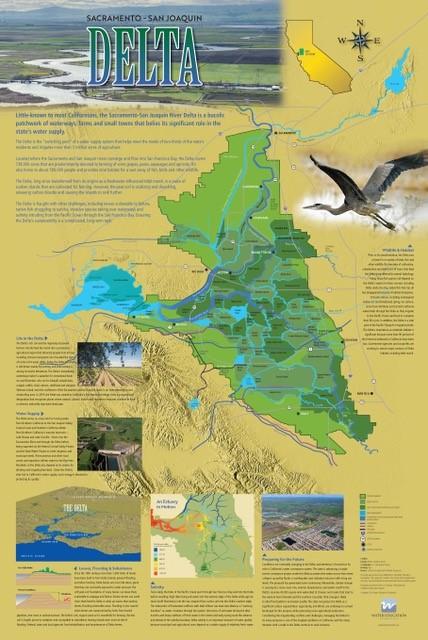Spring 2022 California Project WET Gazette
Volume XXVll, Issue Il
Saving Water in a Changing Climate
The leaf buds on the blue oak outside my home office window are just beginning to swell with new life, even as spring wildflowers and daffodils are already on full display in the yard below. The flowers are all at least 3 weeks early this year, and the sea of green grass around them is already patched with large yellowish swathes of desiccation. In past years, the jagged blue peaks of the Sierra looking well-capped with snow from a recent storm would be a comforting harbinger of summer water supplies, but I know this year it is just a tantalizing veneer.
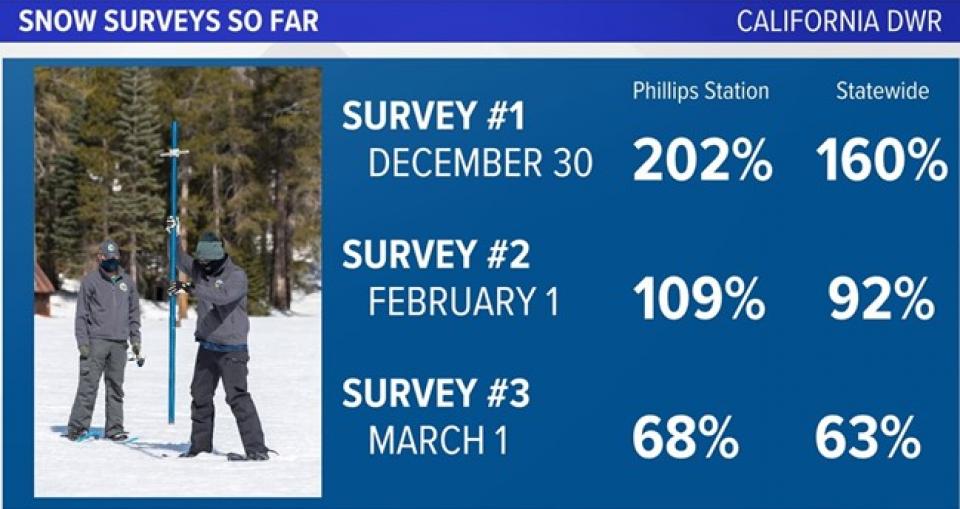 California began 2022 with a snowpack near 160% of normal but following a January and February that will enter records as the driest documented in state history, the March 1st snow survey results calculated water content of the statewide snowpack at only 63% of normal to date and the snowmelt forecast at 66% of average. Add to that a March 1st statewide reservoir storage at about 73% of average, with our largest reservoir Lake Shasta at only 37% full, and it is clear the drought continues and all of us are going to need to knuckle down on conserving water.
California began 2022 with a snowpack near 160% of normal but following a January and February that will enter records as the driest documented in state history, the March 1st snow survey results calculated water content of the statewide snowpack at only 63% of normal to date and the snowmelt forecast at 66% of average. Add to that a March 1st statewide reservoir storage at about 73% of average, with our largest reservoir Lake Shasta at only 37% full, and it is clear the drought continues and all of us are going to need to knuckle down on conserving water.
Drought is a naturally occurring pattern throughout the western United States, a pattern evident in tree ring data stretching back over millennia. So too are rare periods of megadrought – prolonged drought periods lasting two decades or longer. According to a recent study, we are now officially in a megadrought – one that would not have been as severe were it not for the rampant increase in greenhouse gases in the atmosphere from human activities in recent centuries. Our recent history now ranks as the driest 22-year period in at least 1,200 years. Vikings were just beginning their raids on Europe and the western hemisphere was still the sole realm of Native American tribal nations last time it was this dry.
People may be getting tired of hearing the pleas for conservation. But as noted in a previous Gazette, water conservation IS a climate action – and a very powerful one in California, where water is used to generate energy and energy is used to treat and move water. Our simple choices when combined with those of others in our communities ease the strain on our aging water and energy systems and reduce the amount of carbon-producing energy needed to meet our water demand. And water conservation IS a climate action that anyone of any age can do!
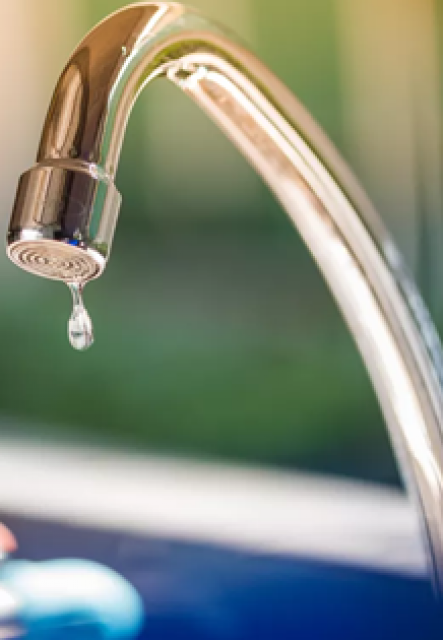 Some think water conservation is a silly waste of time. But small leaks can add up to huge volumes of water and dollars lost on water bills. See for yourself by engaging your students in the Project WET activity ‘Money Down the Drain’ (p: 351), which has students measuring different sized leaks and calculating the rate of water loss and cost if left uncorrected over different time periods. Participants in this activity are usually shocked at the amount of water even a barely dripping faucet can lose over a month or year if left in disrepair.
Some think water conservation is a silly waste of time. But small leaks can add up to huge volumes of water and dollars lost on water bills. See for yourself by engaging your students in the Project WET activity ‘Money Down the Drain’ (p: 351), which has students measuring different sized leaks and calculating the rate of water loss and cost if left uncorrected over different time periods. Participants in this activity are usually shocked at the amount of water even a barely dripping faucet can lose over a month or year if left in disrepair.
Most are equally shocked at how little that same volume of water will cost on water bills throughout much of the state, despite rising water rates and rhetoric from ratepayers claiming the opposite. I give students local water provider rates and a few rate examples from other parts of the state to calculate the cost of their leaks. I also provide the local prices for bottled water, or the bulk water sold in store refill stations to let people see what water could cost in an unregulated open market.
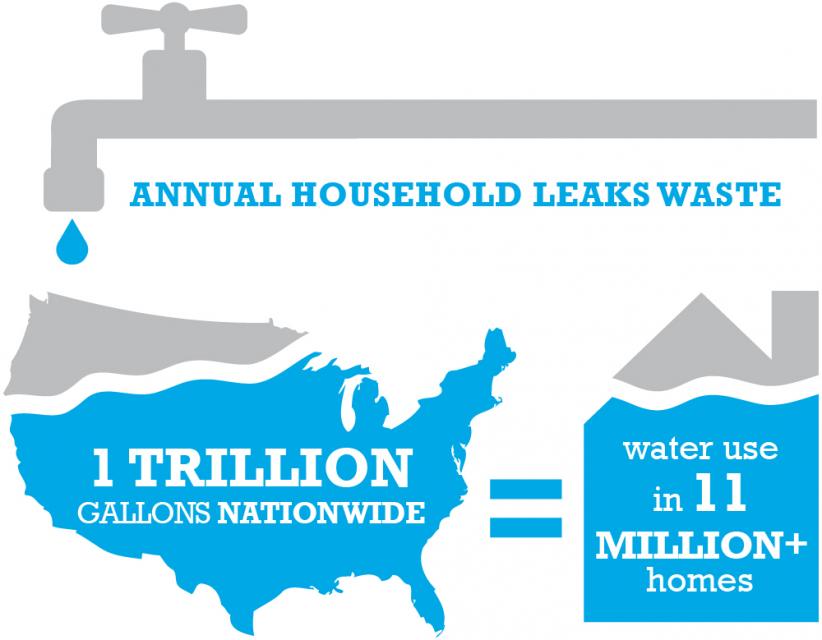 People also tend to forget most of us are part of a municipal water system and collectively pay for the delivery and treatment of water – and small leaks across thousands of homes and businesses due to aging infrastructure or carelessness add up to huge systemwide losses we are also paying for. The ‘Money Down the Drain’ (p: 351) extension activity has students studying a model demonstrating systemic loss and calculating a water-loss ratio for the model system.
People also tend to forget most of us are part of a municipal water system and collectively pay for the delivery and treatment of water – and small leaks across thousands of homes and businesses due to aging infrastructure or carelessness add up to huge systemwide losses we are also paying for. The ‘Money Down the Drain’ (p: 351) extension activity has students studying a model demonstrating systemic loss and calculating a water-loss ratio for the model system.
Leaks threaten the quality and reliability of our drinking water and billions of gallons of water are lost every day from U.S. drinking water systems. A recent study of my local water system is a case in point. The study revealed a 37% loss rate in our system, primarily due to aging 50-year-old residential connections. It is concerning as the study shows that, combined with a design flaw, our system cannot deliver enough water for a dozen or so fire hydrants or to customers on the far ends of the system during peak summer and fall use – i.e., the peak of fire season.
The water agency proposed a water rate increase plan that created a fiery communitywide debate, perfect for use in the suggested extension for ‘The Price is Right’ (p: 357) activity highlighted in the Winter Gazette. The extension suggests students use what they learned in the ‘The Price is Right’ activity to study a local water project by taking on the roles of project designers and the bankers they are trying to receive funds from for the project. I’d suggest changing ‘bankers’ to ‘ratepayers’ who can use the same questions in the activity and develop more of their own to question the students posing as the project designers.
For many, our local decision boiled down to clear evidence of a rapidly deteriorating system and no clear way in the immediate future to cover the costs without raising rates. No one likes paying higher rates or more in taxes, but a failed water system is a quick way to see property values evaporate. And the estimated $10 a day we’ll be paying for water once the full rate increase is reached over the next few years is still a bargain to sustain our household, a dozen or so chickens, few small livestock and landscaping scattered over acre and a half. Many pay this now to cover a daily coffee addiction.
However, to mitigate this rate increase, I have been putting the lessons students learn in ‘Water Audit’ (p: 469) to use in evaluating all aspects of our home water system – indoors and out. As a recent Project WET workshop participant noted, many ‘water audits’ only look at the total volume of water flowing into a home. ‘Water Audit’ has students going far more in-depth, measuring water flow rates of faucets, researching water-use rates of appliances, and even calculating an estimate of water used to produce the power of light bulbs used in the home.
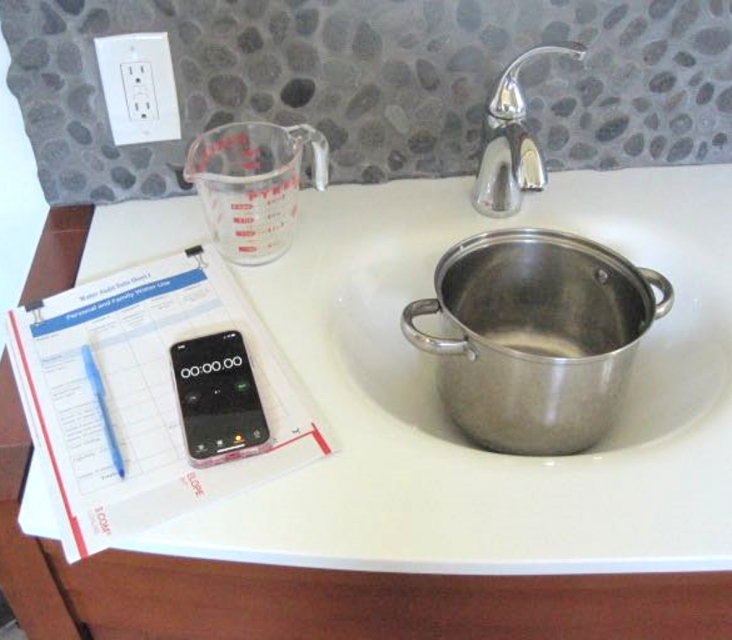 ‘Water Audit’ also has students comparing behavioral changes and technological solutions for conserving water and analyzing which options will be economically and consistently more effective at conserving water. The result of the activity for students of any age is a very detailed accounting of water use by fixture and appliances throughout the home and a plan for boosting water-use efficiency. The plan also adapts the home for changing climate conditions with long-term savings in water, energy and dollars.
‘Water Audit’ also has students comparing behavioral changes and technological solutions for conserving water and analyzing which options will be economically and consistently more effective at conserving water. The result of the activity for students of any age is a very detailed accounting of water use by fixture and appliances throughout the home and a plan for boosting water-use efficiency. The plan also adapts the home for changing climate conditions with long-term savings in water, energy and dollars.
Anyone who has done the activity ‘Thirsty Plants’ (Portal) has observed for themselves how much water a plant can transpire in just a few hours. Landscapes often consume 30% to 60% of a home water budget. I’ve been applying the investigation strategy from the ‘Irrigation Interpretation’ (Portal) activity to our yard to comparing the surface area, depth and longevity of soil dampened by different irrigation methods. Hand-watering is considered the most efficient method to conserve and we can keep up with plant water needs while temperatures are cool.
Unfortunately, with busy work schedules we don’t have the time to keep up with evapotranspiration rates once the heat kicks in. I need to resort to an automated drip system by mid-spring. Though it uses far less water than the sprinkler and water cannon system that came with the house, there are always several failed drip heads or line breaks to deal with each year and it requires constant checking of the system to catch problems before too much water is wasted or plants die. However, it turns my home system into a real-life model to test new and different types of drip technology, rather than the simulations suggested in ‘Irrigation Interpretation.’
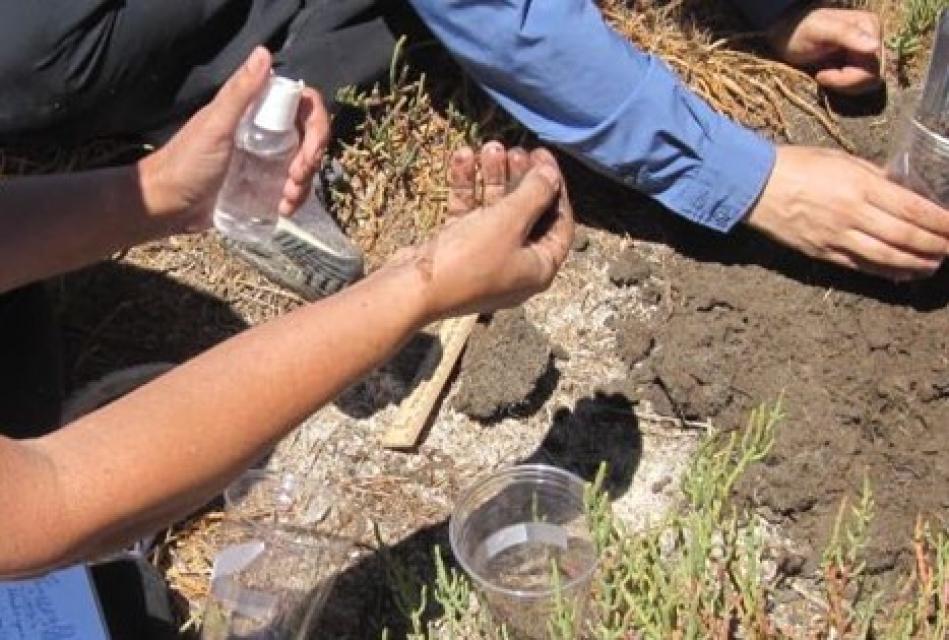 I’ve also learned so much about the variation in soils in our yard while preparing comparison samples for the ‘Wetland Soils in Living Color’ (p: 217) activity, which has also helped me better teach the activity. I now have a very good understanding of soil depth, texture and correlation to plant growth and water demand throughout our yard. This knowledge has guided my extended ‘Irrigation Interpretation’ tinkering and practices on where to plant, what to plant and how to better manage soil cover, mulch or soil amendments in different areas to better conserve water.
I’ve also learned so much about the variation in soils in our yard while preparing comparison samples for the ‘Wetland Soils in Living Color’ (p: 217) activity, which has also helped me better teach the activity. I now have a very good understanding of soil depth, texture and correlation to plant growth and water demand throughout our yard. This knowledge has guided my extended ‘Irrigation Interpretation’ tinkering and practices on where to plant, what to plant and how to better manage soil cover, mulch or soil amendments in different areas to better conserve water.
I’ve also been inspired by teaching the activity ‘Water Concentration’ (Portal). It helps that my love of history and science are combined in the activity, but so too is our current global drive for more sustainable options for delivering and using all natural resources, which this activity specifically focuses on. I’ve noted the activity has students analyzing and assessing the history of individual home water-use practices, then using the knowledge to design a more sustainable future version.
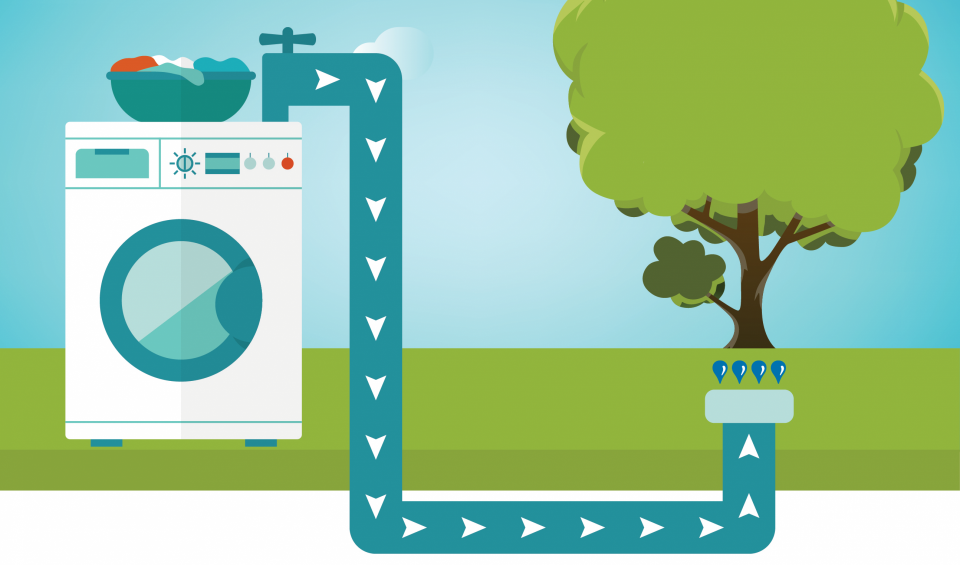 What I have failed to note before is ‘Water Concentration’ also has students analyzing their current home water devices and learning how they can be better used to conserve water, energy and any other resources attached to their use. This and the engineering design portions of the activity were the inspirations for the grey water system now connected to our clothes washer. That has greatly reduced the need to water a portion of our yard as much – a huge savings in water and dollars for a fairly minimal cost to install!
What I have failed to note before is ‘Water Concentration’ also has students analyzing their current home water devices and learning how they can be better used to conserve water, energy and any other resources attached to their use. This and the engineering design portions of the activity were the inspirations for the grey water system now connected to our clothes washer. That has greatly reduced the need to water a portion of our yard as much – a huge savings in water and dollars for a fairly minimal cost to install!
My point in highlighting these activities again is of course driven in part by the severity of our current drought, but also to demonstrate the concepts and skills embedded in Project WET activities are practical. We as adults can often learn as much as our students while guiding them through the activities. They were designed so that those concepts and skills could be applied to real-life examples or to benefit the lives of the learners whether they are school-age or ‘more experienced in years.’
I hope you try some of the water conservation activities above or others in your Project WET resources with your students this spring. In addition to addressing the drought, many are perfect for getting kids outside and engaged as ‘springitis’ kicks in with the approaching end of the school year. The Websites of Interest is loaded with a variety of resources to go with the activities and the article above and others. Check out the Spring Events and Professional Development Opportunities – and the roster of Grants, Awards, & Student Opportunities.
Hope you have a wonderful spring!
WEBSITES OF INTEREST
Article: ‘Megadrought in southwestern North America is region’s driest in at least 1,200 years’
Thanks to the region’s high temperatures and low precipitation levels from summer 2020 through summer 2021, the current drought has exceeded the severity of a late-1500s megadrought that previously had been identified as the driest such drought in the 1,200 years that the scientists studied.
Welcome to California Water Watch! This site offers the most current local and statewide water conditions down to your region and even your neighborhood. Learn about current statewide hydroclimate and water supply conditions, including precipitation, temperature, reservoir storage, groundwater conditions, snowpack, streamflow, soil moisture and vegetation conditions. To view the conditions in your local area, enter your address or zip code in the location finder.
Save Our Water is a statewide program aimed at helping Californians reduce their everyday water use. Browse the Save Our Water website to uncover ideas on saving water indoors and out. You’ll find water conservation tips, tools for calculating your water use, fun ways for kids to save water and to permanently reduce water use – regardless of whether California is in a drought.
Use this project of the Alliance for Water Efficiency in conjunction with the Project WET activity ‘Water Audit’ (p: 469) for a deeper dive into behavioral and technological water conservation practices for both indoor and outdoor water use. Simple, minor adjustments to your house and your behavior can work wonders when it comes to water conservation.
U.S. Geological Survey: Water Science School – Home Use
How much is your daily indoor water use? Enter your use data from the Project WET ‘My Water Footprint’ (p: 441) activity, choose the submit button, and we’ll give you an estimate of how many gallons of water you used. NOTE: Our survey here is very general in nature…just to give you a quick idea of your water use, but we have links to more accurate calculators on this page!
U.S. Geological Survey: Water Science School – Drip Calculator
How much water does a leaking faucet waste? This page allows students to enter their data from the Project WET ‘Money Down the Drain’ (p: 351) activity to help calculate the volume of water being lost, while also providing wonderful questions and links to pique their water conservation curiosity!
The Association of California Water Agencies (ACWA) is the largest statewide coalition of public water agencies in the country. Urban and agriculture water agencies are responding with conservation goals, water efficiency programs, long-term resiliency planning and other steps as the drought continues in California. Click here to see if your water provider is a member agency and what water use restrictions and conservation rebates may be available.
In Southern California, conservation helps reduce overall regional water demands and ensure greater supply reliability for the region. To see what rebates are offered in your area, please visit Estimate Your Rebate. The SoCal Water$mart program is a partnership between the Metropolitan Water District of Southern California (Metropolitan) and its 26 member agencies throughout Southern California.
Be Water Smart is a public outreach-and school education-focused program sponsored by the Regional Water Authority’s Water Efficiency Program (WEP) and 19 water providers. These water providers in Sacramento, Placer and El Dorado counties plus the City of West Sacramento are working together to help their customers use water efficiently.
Water efficiency is the smart use of our water resources through water-saving technologies and simple steps we can all take around the house. Using water efficiently will help ensure reliable water supplies today and for future generations. Best of all, everyone can play their part in preserving our nation’s water resources. With the simple steps and informational tools on this page, you’ll find that it’s easier than ever.
Using water-saving techniques can save you money and diverts less water from our rivers, bays, and estuaries, which helps keep the environment healthy. It can also reduce water and wastewater treatment costs and the amount of energy used to treat, pump, and heat water. Homes with high-efficiency plumbing fixtures and appliances save about 30 percent of indoor water use and yield substantial savings on water, sewer, and energy bills.
We are a collaborative group of educators, designers, builders, and artists who educate and empower people to build sustainable water culture and infrastructure. Using water from sinks, showers and washing machines to irrigate plants is a way to increase the productivity of sustainable backyard ecosystems that produce food, clean water, and shelter wildlife.
Shreya Ramachandran founded The Grey Water Project in 2016. The Grey Water Project is a nonprofit aimed at promoting the safe reuse of grey water and water conservation, through outreach, advocacy, policy changes and grey water curricula. Whether you install a grey water system, advocate for water policy change, fix a leak, or just take a shorter shower, every drop counts.
Welcome to bewaterwise.com, Metropolitan Water District’s portal for water-saving rebates and grants, landscape classes, water-wise garden inspiration and tons of helpful tips on how to lower your water use. Up to 70 percent of residential water use is for landscape. Check-out our Watering Calculator tool to estimate the correct amount of water to give your landscape or garden every week.
Water Wise Gardening in the Bay Area
In California, more than half of the water used at your home is for outside purposes. Studies show that on average, half of the water used outdoors is wasted. The leading cause of waste is incorrectly set and poorly managed irrigation controllers. The Water Calculator is intended to give you crucial advice on how to set your controller properly and how to manage it thereafter.
Water dedicated to landscape can often be reduced by 20 to 40 percent because over irrigation is very common. Gradually reduce the amount of water applied over a few weeks – giving lawns, trees and plants time to adjust. Water restrictions and conservation should be taken into consideration when deciding on starting an edible home garden.
California Water Conservation Rebates
Rain Bird has collected a list of links to various water conservation rebate programs by agency. Water-efficient irrigation technology can help everyone lower their water consumption, save money, and maintain a healthy and beautiful landscape that reduces pollution and cools the environment. Many municipalities and water agencies offer substantial rebates and financial incentives to help offset the cost of upgrading to highly efficient irrigation equipment.
Home composting is an effective and efficient way to dramatically reduce your waste stream at home, while doing your part to reduce your carbon footprint and conserve soil moisture. Organic material sent to landfill creates methane, a powerful greenhouse gas that contributes to the negative impacts of our changing climate.
California Department of Water Resources: Education
You’ll find a variety of resources to support water education in and out of the classroom. Our free supplementary materials for K-12 educators and parents can help students learn about California’s diverse water resources. Our website also includes links to real-time data, online games, local agency programs and to our ‘Water Wednesdays’ You Tube recordings of conversations on a range of water topics.
PROFESSIONAL DEVELOPMENT OPPORTUNITIES
California Project WET Workshops
Join us this spring for Project WET workshops focused on Project WET activities to engage students in not only studying the variables in weather and climate influencing drought, but also actions that can be taken to mitigate or adapt our homes, schools and larger communities for a more arid climate. Our spring workshops include online, hybrid and fully in-person opportunities – and in-person sessions will highlight activities that can be done outside or inside the classroom.
California Project Learning Tree Workshops
Project Learning Tree uses trees and forests as windows on the world to increase students’ understanding of the environment and actions they can take to conserve it. The program in California delivers regular workshops for educators interested in using trees and forests as windows to the world. Trainings are offered to schools, teachers, parents, students and other non-profit organizations for outdoor environmental education programs.
Forestry Institute for Teachers
Enjoy a week with natural resource professionals and advocates gaining a deeper understanding of forest ecosystems and human use of natural resources. Participants receive a high-quality professional development experience focused on interdisciplinary content and practices at the heart of current forest issues – as well as Common Core and Next Generation Science Standards. You’ll leave with a wealth of environmental education curriculum- including Project Learning Tree and Project WET!
California Water Institutes for Teachers
Participants take part in an intensive three days focused on a region’s complex water resources, system ties to the State Water Project and first-hand experiential learning. Our place-based learning experiences will provide teachers with the tools to support students development of environmental literacy skills focused on the watersheds where they live and recreate. Our 2022 institutes will occur in Solano, Butte and southern Sacramento Counties.
Understanding Climate Change in California Workshops
These specialized Project WET workshops provide an opportunity for new and veteran Project WET educators to interact with members of the California Department of Water Resources (DWR) Climate team for a day learning about climate science, its use in safeguarding California water resources and use of Project WET activities to integrate climate science concepts and skills back in the classroom – Join us in western Merced County this summer!
SMUD Free Professional Development Workshops
All of our classes are free and most provide materials you can use in your own classroom. This spring, we are offering a mix of virtual and live workshops. We will be following strict safety measures at all of our live workshops, with social distancing, rooms at 25% capacity, furniture cleaned and disinfected and mask requirements as per state and county guidelines.
California Environmental Education Interagency Network
The California Environmental Education Interagency Network is a state government consortium of environmental educators representing state departments and partner organizations. The partnership maintains an online calendar, where educators can find a workshop experiences and participatory stewardship opportunities related to environmental education and environmental literacy offered by the partnership.
SPRING EVENTS
March 22, 2022: World Water Day
“Groundwater: Making the Invisible Visible” highlights this invisible but vital water resource that provides almost half of all worldwide drinking water, about 40% of water for irrigated agriculture and about 1/3 of water required for industry. A resource humans are rapidly depleting. It sustains ecosystems, maintains the base flow of rivers and prevents land subsidence and seawater intrusion.
April 1, 2022: Virtual California Farm Day
Join us virtually to celebrate agriculture while learning about the “99% Club!” California produces 99% of the nation’s production of 16 commodities that are enjoyed throughout the United States and the world – almonds, olives, garlic artichokes and kiwis…to name a few! There’s no cost to participate.
April 18 – 22, 2022: National Environmental Education Week
Instead of packing all of our educational resources and events into a handful of days in late April, we have decided to expand our EE offerings throughout the year. We hope you are as excited as we are to begin this new era of year-round environmental education.
April 22, 2022: Earth Day 2022
The Earth Day 2022 Theme is ‘Invest In Our Planet. What Will You Do?’ We need to act (boldly), innovate (broadly), and implement (equitably) while there is still time to solve the climate crisis – time to choose BOTH a prosperous and sustainable future, and time to restore nature and build a healthy planet for our children and their children.
April 25-29, 2022: Children’s Water Education Festival
The Children’s Water Education Festival returns in a virtual format. The Festival presents a unique opportunity to educate third, fourth and fifth grade Orange County students about the environment. Through a series of interactive and immersive live and on-demand presentations taught by well-known and respected experts and organizations, students learn about a variety of environmental subjects.
May 13 – 15, 2022: AEOE Statewide Spring Conference
Join us at SCICON in Springville, CA (Tulare County) for a weekend of learning, networking, and fun. The conference is held Friday evening through Sunday lunch and includes 30+ workshops, keynote speakers, an awards ceremony, silent auction, evening entertainment, and more. Lodging and meals are offered onsite and both camping and cabin dorm accommodations are available.
May 2022: California Water Awareness Month
Californians have made great progress in recent years embracing wise water use as a daily habit. It is more critical than ever that Californians work together to Save Our Water and make the world a better place for our children, grandchildren, and future generations.
June 4 – 12, 2022: California Invasive Species Action Week
Help us celebrate California’s Invasive Species Action Week, by volunteering to take action to help stop the spread of invasive species, find an event near you by visiting our list of 2021 Schedule of Events! Don’t forget to check out the Project WET activity ‘Invaders’ (p: 263)– and checkout this website for recipes for a variety of invasive species!
June 8, 2022: World Ocean Day
Our ocean covers 70% of the planet and supports life as we know it. Every second breath we take comes from the ocean. Our ocean feeds billions of people and hosts 80% of the Earth’s biodiversity. World Oceans Day is a day to take action and raise awareness. From raising awareness to taking action or simply enjoying sustainable seafood, there’s plenty you can do to take part this World Oceans Day.
GRANTS, AWARDS & STUDENT OPPORTUNITIES
Metropolitan Water District Community Partnering Program
Metropolitan’s Community Partnering Program provides up to $2,000 in sponsorships to community-based organizations that include non-profits, educational institutions and public agencies. Eligible projects include water-related educational outreach programs like community forums, workshops and water festivals, water-themed curriculum and supplies for grades K-12, after-school programs, exhibits, promotional materials and native plant and California Friendly® garden signage.
The Forestry Challenge
The Forestry Challenge is an academic event for high school students in technical forestry and current forestry topics. Participants spend four days in the forest learning about the ecology and management of the forested landscapes that provide communities with water, recreational opportunities, wood products, and wildlife habitat. Fall 2022 Pre-registration – Now Open!
Garden Grant Program – Deadline: March 31, 2022
Through the Garden Grant Program, outdoor spaces can be turned into gardens that engage in hands-on learning opportunities and connect students to their food source. The Whole Kids Foundation is awarding $3,000 grants to K-12 schools or non-profit organizations that serve K-12 students to support new or existing edible educational gardens.
Climate Video Challenge – Deadline: March 31, 2022
Millions of people around the world – especially youth – are fighting to prevent and adapt to climate change, while creating more equity and balanced justice in how we relate to one another as citizens. The California Coastal Commission challenges California middle and high school students to answer the question: ‘What is your vision for a thriving future?’
Invasive Species Youth Art Contest – Deadline: April 1, 2022
Create an original piece showing how Californians can work together and “Unite to Fight Invasive Species!” Be creative! All types of media are welcome and encouraged: drawings, paintings, mixed media, sculpture, animations, comic strips, videos, audio!
Stockholm Junior Water Prize – Deadline: April 15, 2022
The Stockholm Junior Water Prize competition is the world’s most prestigious water-science competition for students. The purpose of the SJWP program is to increase students’ interest in water-related issues and research and to raise awareness about global water challenges. The winner of the California competition will advance to the national level, and the winner of that event will represent America at the global competition in Sweden.
Gloria Barron Prize for Young Heroes – Deadline: April 15, 2022
The Gloria Barron Prize annually honors 25 outstanding young leaders ages 8 to 18 from across America and Canada who have made a significant positive impact on people, their communities, and the environment. The goal of the Prize is to shine the spotlight on these amazing young people so that their stories will inspire others. The top ten winners each receive a $10,000 to be applied to their higher education or to their service project.
The Geosciences Bridge Program – Deadline: April 22, 2022
The Geosciences Bridge Program offers a 6-week paid internship for high school students planning to pursue careers in the geosciences. The program includes lectures, field trips, hands-on activities, two for-credit college courses, housing, meals, travel to and from the University of Maryland Eastern Shore (UMES), and a stipend.
Ocean Awareness Student Contest – Deadline: June 13, 2022
The annual Ocean Awareness Contest is a platform for young people to learn about environmental issues through art-making and creative communication, explore their relationship to a changing world, and become advocates for positive change. Students ages 11-18 from around the world are invited to participate.
CREDITS
California Project WET Gazette is published by the Water Education Foundation, which serves as the state coordinator and host institution for Project WET USA, a program of the Project WET Foundation
This material is based upon work supported by the U.S. Geological Survey under Cooperative Agreement # GG1AC10429. The views and conclusions contained in this document are those of the authors and should not be interpreted as representing the opinions or policies of the U.S. Geological Survey. Mention of trade names or commercial products does not constitute their endorsement by the U.S. Geological Survey.
Editor: Brian Brown, California Project WET Coordinator
Email me here with questions or recommendations for the Gazette!
Water Education Foundation
2151 River Plaza Drive, Suite 205
Sacramento CA 95833
916.444.6240
www.watereducation.org









